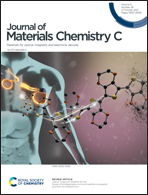Highly efficient and stable quantum dot light-emitting devices with a low-temperature tin oxide electron transport layer†
Abstract
Solution processed metal oxides with the characteristics of low cost, high mobility and good transparency are promising materials for the carrier transport layer of optoelectronic devices. So far, solar cells with tin oxide (SnO2) transport layers have been demonstrated to achieve high efficiency and long-term stability. However, it is still a challenge to achieve highly efficient and long-term stable quantum dot light-emitting devices (QLEDs) with SnO2. Here, we prepared QLEDs with a low-temperature SnO2 electron transport layer (ETL), and found that the residual hydroxyl group (–OH) seriously degenerates the operating lifetime of the QLEDs. UV-Ozone treatment (UVO) is then proposed to decompose the residual tin hydroxide into stoichiometric SnO2. Compared with the control QLEDs with SnO2 without UVO, the QLEDs with UVO SnO2 possess the same efficiency, but show a nearly two times higher operating lifetime. With an initial luminance of 500 cd m−2, the QLEDs with UVO SnO2 show a half-luminance operating time of 2168 h, while that of the control device is only 1015 h.



 Please wait while we load your content...
Please wait while we load your content...